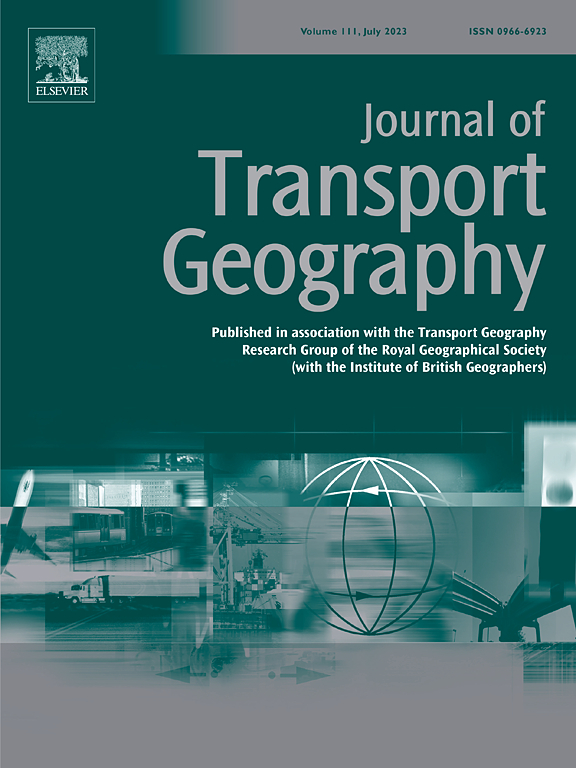评估公交可达性对就业密度的影响:基于重力的可达性空间分析,纳入工作匹配、公交服务类型以及首/末英里模式
IF 5.7
2区 工程技术
Q1 ECONOMICS
引用次数: 0
摘要
交通经济学研究表明,活动密度,尤其是就业密度,受到包括公共交通在内的交通基础设施和服务的可用性和质量的影响。这些研究还表明,企业和经济活动可能有独特的要求、偏好和特点,这可能会导致交通对不同行业产生不同的影响。然而,在过去的研究中,人们大多使用简单的公交邻近距离或旅行时间来研究公交基础设施与就业密度之间的关系,很少有人使用公交可达性,也没有人考虑到第一/最后一英里(FMLM)模式、不同的公共交通服务类型和就业匹配机制。本研究试图利用一种适应上述特征的新的可达性测量方法,并比较其与各行业就业密度的关系,从而填补这些空白。研究结果表明,在所有行业部门,就业密度与公交服务可达性之间存在显著的正相关关系,而轻轨服务的影响仅在金融、房地产、保险、食品和住宿行业部门以及采用 FMLM 模式时显著。与可达性相比,与公共交通的邻近程度更能预测就业密度。此外,在所有行业中,靠近高速公路网络的影响几乎是靠近公共交通影响的两倍,尤其是对蓝领工作而言。研究结果还突出表明,工业部门倾向于聚集在就业多样性较高的地区,但对土地利用多样性较高的地区却无动于衷。这些结果表明,在交通公平和多式联运规划与政策方面存在一些挑战。通过协调有形基础设施、票价系统和时间表来改善区域公共交通一体化,同时加强关键区域的步行设施,可以改善活动之间的连接性。此外,将公平因素纳入土地利用规划,如通过分布影响分析,有助于监测和确保未来城市发展的公平性。本文章由计算机程序翻译,如有差异,请以英文原文为准。
Assessing the impact of transit accessibility on employment density: A spatial analysis of gravity-based accessibility incorporating job matching, transit service types, and first/last mile modes
Transportation economics studies show that the activity density, in particular, employment density, is influenced by availability and quality of transportation infrastructure and services, including public transit. These studies also show that businesses and economic activities may have unique requirements, preferences, and characteristics, which may lead to varying effect of transportation on different sectors. However, the relationship between transit infrastructure and employment density has been examined mostly using simple transit proximity distance or travel time in the past research and few have used transit accessibility, and none have accounted for first/last mile (FMLM) modality, different public transit service type, and job matching mechanisms. This study attempts to fill these gaps by utilizing a new accessibility measure that is adaptive to the aforesaid features and comparing its relationship with employment density across various industries. The results show a positive and significant relationship between employment density and bus service accessibility for all industrial sectors, while the effect of light rail service is significant only for finance, real estate, insurance, food, and accommodation industrial sectors, and when FMLM modality is driving. Proximity to public transit was found to be a stronger predictor of job density than accessibility. Additionally, the effect of closeness to highway network was almost twice the effect of transit proximity for all sectors, especially for blue-collar jobs. The results also highlight that industrial sectors tend to cluster in areas with higher employment diversity but are indifferent towards higher land use diversity. These results signify several challenges in transportation equity and multimodal planning and policies. Improving regional public transit integration through coordinated physical infrastructure, fare systems, and schedules, along with enhancing walking amenities in key areas, could improve connectivity between activities. Additionally, incorporating equity considerations into land use planning, such as through distributional impact analysis, can help monitor and ensure equity in future urban developments.
求助全文
通过发布文献求助,成功后即可免费获取论文全文。
去求助
来源期刊

Journal of Transport Geography
Multiple-
CiteScore
11.50
自引率
11.50%
发文量
197
期刊介绍:
A major resurgence has occurred in transport geography in the wake of political and policy changes, huge transport infrastructure projects and responses to urban traffic congestion. The Journal of Transport Geography provides a central focus for developments in this rapidly expanding sub-discipline.
 求助内容:
求助内容: 应助结果提醒方式:
应助结果提醒方式:


